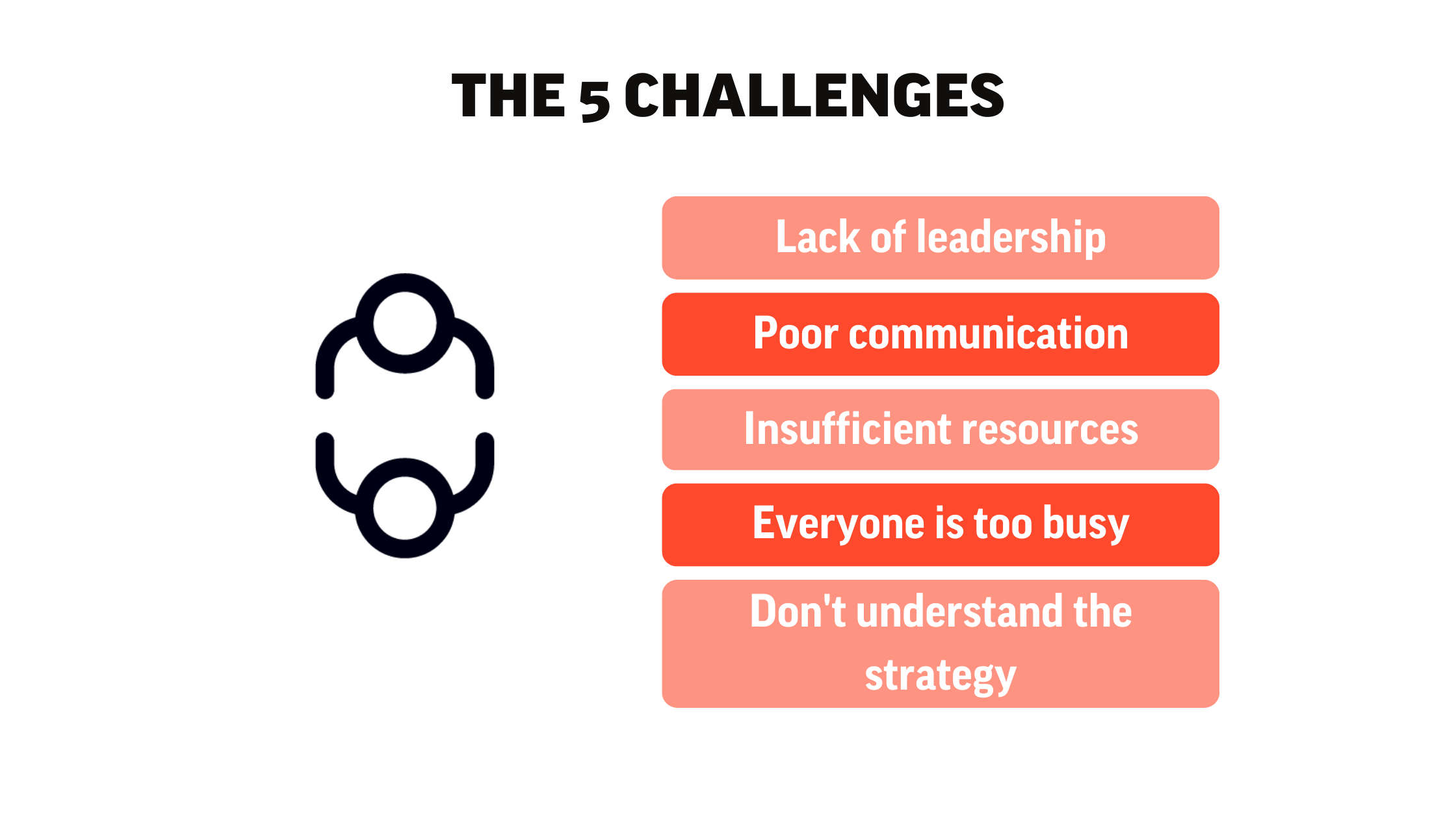8 Tips for Successfully Executing a Strategy

Strategies come in endless variations, that is their beauty, fascination and vast potential. It can also be their complication. Strategies are crucial to all facets of business and target things such as launching a new product, recruiting best talent, reaching yearly budgets and anything in between. No matter the size of your strategic plan, there are key factors that will significantly affect the chances of successfully executing your strategy.
This article will dive deeper into how you can approach some of the challenges you might face when implementing a strategic plan.
Execution determines whether your strategy will succeed
There’s no doubt that planning has a significant impact on implementing a new strategic framework. In the planning phase, you can estimate the required effort and what you will gain from it. Leaders often spend many hours in this stage. However, you can only plan up to a certain point. Sooner or later, the success of your strategy will depend on how well you implement and execute it and, most importantly, that you actually start executing the strategy!
The top 5 challenges when executing a strategy
A high percentage of strategies fail because they are not executed properly. To minimize the risk of joining that high percentage group that fail in the execution stage, we can look into the experiences of others who have suffered failed strategies.
Studies by George Washington University, LBL Strategies, and the Association for Strategic Planning suggest that the top five strategy challenges are people-related.
These challenges can be boiled down to five social aspects of strategy: lack of leadership, poor communication, insufficient resources, everyone being too busy, not understanding the strategy that is about to be executed. It is also worth looking into your own previous strategies. What was successful? What was less successful? What can you improve for future implementation? Knowing the real challenges makes it easier to understand how to avoid the pitfalls.
It is also worth looking into your own previous strategies. What was successful? What was less successful? What can you improve for future implementation? Knowing the real challenges makes it easier to understand how to avoid the pitfalls.
How to achieve successful strategy execution
Creating the best possible conditions for successful strategy execution is essential. Use your strategy framework and the insights into the Top 5 challenges of execution mentioned above to ensure a great starting point and foundation.
However, to increase your chances of success, you must have a clear plan for how to translate your plan into action. Therefore, we have gathered eight tips for how to successfully implement your new strategy.
1. Values, mission, and strategy – are they aligned?
Ensure that your brand's values, mission, and vision align with your strategy. A connection between your core values and the strategy creates a coherent experience for both customers and employees. It will also function as a guide with decision-making along the process, giving you a clear path towards your company's overall goals.

2. Planning for implementation and execution
A strategic plan should include an implementation framework. However, this plan might need some additional work to make sense to people who have not been part of the planning process.
Depending on the strategy, different departments might be involved when executing. In that case, you may have to tweak the implementation plan or make separate versions to make it relevant and coherent and understandable for each department.

3. Communicating
As previously mentioned, one of the more significant challenges when successfully executing a strategy is communicating effectively. So when you’re presenting your plan, make sure to include both why you are implementing it and how you will do it. In other words, every involved department needs to be fully aware of why and how the strategy will be implemented.
Colleagues and employees who have not been part of the planning process might not have the same clear and detailed understanding of the overall goals and why it is crucial to reach them. Help everyone understand the context of the strategy to increase the chances of a motivated, inspired and effective team.
Make sure to involve the people responsible for the execution at the beginning of the implementation process to ensure they have the necessary information. This will help them facilitate the execution in a straightforward and effective manner. This usually results in a shorter communication process, which is beneficial since it speeds up the execution process.
Good communication is essential no matter the company's size. Misunderstandings and poor communication can be challenging for any business, even ones run by two people.

4. Resources
Usually, a new strategy requires additional or different resources, as well as relocating existing ones. One tip is to look into what your company needs regarding resources to execute the strategy successfully. Even if the leaders have a great plan, without insights into everyday operations, the execution will most likely not reach the target audience.
For your employees and colleagues, a new strategy will probably come with changes in everyday operations. An effective way of understanding what is needed is to ask the involved departments what they require in order to meet the goals. The better your strategy execution plan aligns with what is actually needed, the better chances you have to complete it successfully. You’ll also decrease the risk of delays caused by inefficient workflows.
In this case, resources can be anything from tools to people and frameworks.

5. Who is doing what and when?
Planning and executing are both crucial steps which rely on each other. However, in reality the schedule is tight and everyone is already busy. Ensure that every part of the new implementation is executed by insights about the operational work within all the departments involved.
When you have a good overview you can help your colleagues know exactly what to do on a daily basis. Aim to find a balance between running the current business and making room for the changes you would like to implement.
Without a clear structure, confusion and delays are common outcomes. Connect all the tasks to a department or responsible person and align with them on who is responsible for what. If the strategy affects different departments, set up a concrete workflow that efficiently helps the collaboration.

6. Keeping it agile and asking questions
Preparation is necessary, but you can only prepare up to a certain point. When executing a strategy it is likely you will have to make minor adjustments along the way. In many cases you will also discover new things that impact and influence your plan.
For example, implementing new strategies often demands some restructuring of current workflows. This can be a challenge when it comes to the daily routines of your employees or colleagues. Be responsive to indications of situations that are slowing down the process, or goals that the organization is not reaching. Then, tweak the plan as soon as possible to fit the actual workflow.
An effective way to identify the core of the problem is to ask yourself questions. Of course, these can vary depending on your business and strategy, but to use specific examples that allow you to better pinpoint the concrete adjustments that need to be made
- What is not working and why?
- Do we measure correctly, or do we have to consider other factors?
- What are the implications for our initiatives, strategies and capabilities?
For more tips on what questions to ask when implementing a strategy, see our article “Top ten strategy implementation questions”.
7. Evaluating
Evaluation is an excellent way of understanding how to keep your strategy execution agile. When evaluating, consider both the people-related aspects as well as the actual results in numbers. This will give you a better foundation for achieving success.
Many companies have traditionally worked with quarterly synchronizations. However, waiting months between checkups might be too infrequent in today’s landscape. To execute a strategy successfully, you can gain a lot from weekly or biweekly updates – especially at the beginning of strategy implementation when you benefit from identifying obstacles as soon as possible.

8. Guiding
One of the challenges when executing a strategy successfully is that employees experience a lack of leadership. Make sure a responsible person is available to continuously follow up and assist with guidance as and when required. Listening to and understanding struggles and difficulties that might occur along the way will not only help you make your staff feel heard, but also identify hindrances before they become a bigger problem. 
Examples of successful strategy execution
For an example of successful strategy execution, let’s take a look at Airbnb – a company that has greatly impacted the way we travel.
Airbnb founders Brian Chesky and Joe Gebbia started out offering people mattresses on their floor for a small amount of money. It didn’t take long for them to realize that this could develop into an actual business. After a time, others joined the business as hosts and the founders got a lot more traffic on their site. However, they did not get as many bookings as they wanted and therefore tried to identify why their traffic did not convert.
After some internal and external research, they found that most of their hosts' photos did not live up to the standard of other house-booking sites and services. So the founders decided to visit their hosts with their own camera equipment, taking pictures that would better represent the house and its surroundings.
With better pictures and descriptions of the bookable locations it did not take long for sales to double, then triple and ultimately set Airbnb on the path to becoming one of the most successful travel services we know. By identifying the problem, helping their hosts with the right equipment and knowledge, and creating structured routines that were easy to follow, the two founders successfully executed the strategy of growing their business.
Does your business have everything to execute strategies successfully?
Successful strategy execution depends on a variety of factors. This article can serve as inspiration and as a complement to your strategy. You might also find our Strategy Execution Management platform helpful. It is a tool that helps you to seamlessly adapt your methods and keep track of your process.
By understanding some of the top challenges and how you can approach them, you can create the best conditions for reaching your goals, increasing your chances of successfully executing your strategy and delivering success.
DecideAct's solution will help you achieve and track your strategies' success. Book a free trial and see how.






.png?width=596&name=Financial%20Strategy%20Plan%20(1).png)



.png?width=80&name=USED%20(1).png)